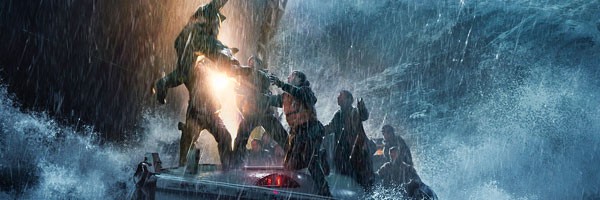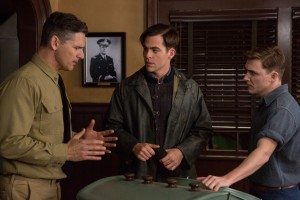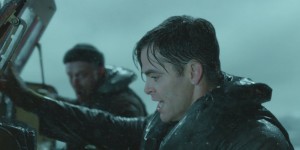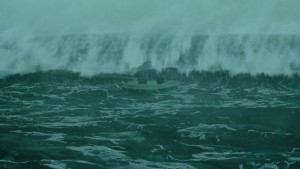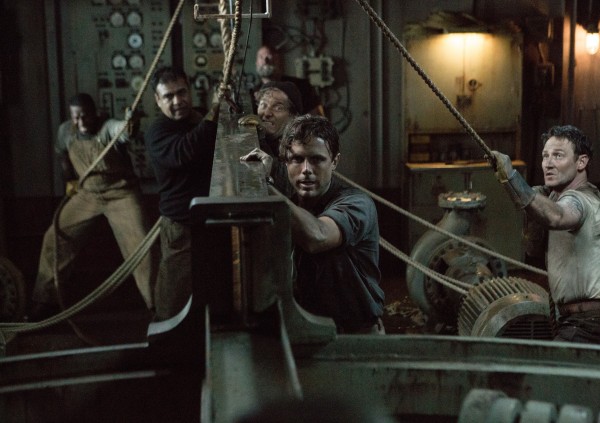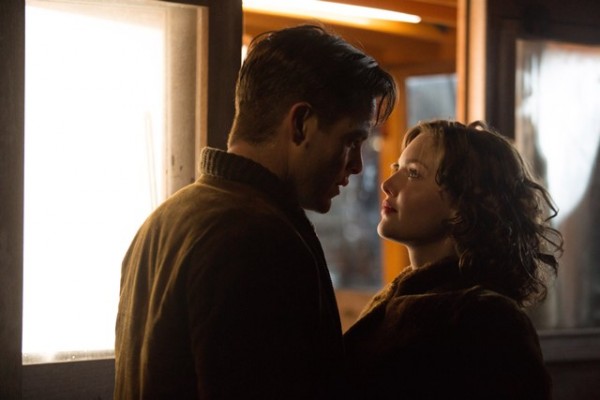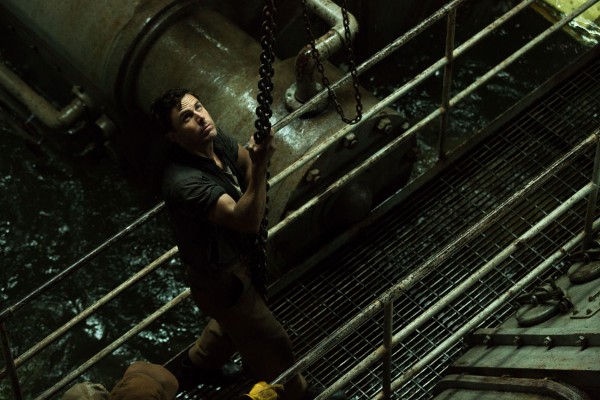By Perri Nemiroff
Collider
January 13, 2016
The crew of the CG36500 that went out to rescue the stranded men aboard the SS Pendleton in the middle of a vicious nor’easter may be humble and have zero interest in boasting about their accomplishment, but on January 29th, we’re going to celebrate their bravery on the big screen in Craig Gillespie’s adaptation of the Casey Sherman book, The Finest Hours: The True Story of the U.S. Coast Guard’s Most Daring Sea Rescue.
The movie will cover what went down on the SS Pendleton after the tanker split in two in the middle of the storm, but during my visit to set back in November 2014, we focused primarily on the crew of the lifeboat that agreed to embark on what seemed like a suicide mission in order to rescue them. Chris Pine leads the film as Bernie Webber, the captain and driver of the CG36500, and he’s joined by novice engine man Andy Fitzgerald (Kyle Gallner), an inexperienced guy on lightship duty named Ervin Maske (John Magaro), and Richard Livesey (Ben Foster), the more seasoned member of the crew who wasn’t thrilled about risking his life with a bunch of third-stringers.
While on the Boston set, we got the chance to watch Pine, Foster and Magaro brave some serious wind and rain while the CG36500 rocked around on a gimbal, tour select sets and chat with Pine, Foster, Magaro, Gallner, Gillespie and producers Dorothy Aufiero and Jim Whittaker during roundtable interviews. Check out some of the highlights below:
Aufiero was pitched the project in a parking lot. 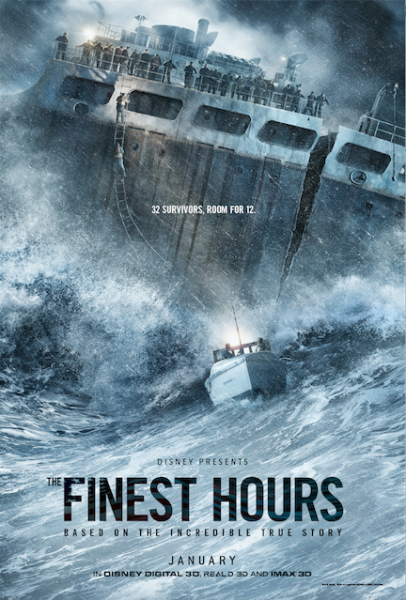 She began, “I was looking at another project that actually is a book that Casey Sherman had done. I had been pitched this project and I was in a meeting to just meet the author. I determined it really wasn’t the story that I was interested in making.” She thought that was that but Sherman wasn’t letting her off the hook that easy. “I was saying my goodbyes and leaving the building and Casey started following me and he said, ‘Can I see you for a minute? Do you mind if I walk you out?’ And I said, ‘No, it’s alright.’ So we went to the parking lot and I was getting close to my car and he whipped out the book The Finest Hours and he said, ‘I have your next big thing.’” She laughed and recalled, “I’m looking at the cover and there’s this tanker sinking and I’m thinking, ‘This is not anything I’m remotely interested in.’ So I said that I’d look at it and he said, ‘I think that it’s Disney.’ So I drove home and later in the afternoon I was flipping through it and I really was completely blown away by the story.”
She began, “I was looking at another project that actually is a book that Casey Sherman had done. I had been pitched this project and I was in a meeting to just meet the author. I determined it really wasn’t the story that I was interested in making.” She thought that was that but Sherman wasn’t letting her off the hook that easy. “I was saying my goodbyes and leaving the building and Casey started following me and he said, ‘Can I see you for a minute? Do you mind if I walk you out?’ And I said, ‘No, it’s alright.’ So we went to the parking lot and I was getting close to my car and he whipped out the book The Finest Hours and he said, ‘I have your next big thing.’” She laughed and recalled, “I’m looking at the cover and there’s this tanker sinking and I’m thinking, ‘This is not anything I’m remotely interested in.’ So I said that I’d look at it and he said, ‘I think that it’s Disney.’ So I drove home and later in the afternoon I was flipping through it and I really was completely blown away by the story.”
The Finest Hours actually is in Disney’s wheelhouse. Here’s how Foster put it; “This isn’t going to be Lone Survivor 2. I think it’s really brave and exciting that Disney’s doing it, but it also feels very much in their wheelhouse from way back when. It feels like a callback to a grander time of, in my opinion, of films that I feel more connected to, the 30s and 40s.” He added, “It’s more about a type of men who don’t go home and tell the town how great they are.”
The heroes of this story are actually the B team. Whitaker explained how the crew of the CG36500 came together; “The first boat goes down, so all of the A-team gets sent out. They’re the underdogs because they’re left over really and they’re the ones that are left behind, right? Because they were put in this position where they had to go out on what was effectively a suicide mission, not everybody really wanted to raise their hand. The ones that did were like Andy Fitzgerald who was a third class engineer man who only went because Mel Gouthro, who was ahead of him as an engineer man, was sick. So Andy ended up signing up and then Maske ended up walking through the door and he just said, ‘Hey, I’ll go too.’ And then Livesey was the third one and Livesey, who Ben Foster plays, was not all that happy about not being chosen on the first team. So he’s a pretty capable guy who is left to be chosen and put together with a group of guys who he knows are lesser in his rank and ability. And that also causes tension with Bernie.”
The simplicity of Bernie is what appealed most to Pine. He noted, “There’s a great recording of Bernie talking to an interviewer years and years ago about the rescue and I guess, above and beyond the heroism of it, you can kind of get the sense that he’s sick of retelling the story, you know? That, for him, this was his job, this was what he was supposed to do and just like anyone clocking in for a job, his task was going out and saving people, and a real sense that there was no glory in it for him or any need for self-aggrandizement. It was just very simple.” Gillespie also added, “Bernie’s really an unusual underdog. He’s one of those antiheroes, the reluctant guy, the last person you’d expect to be that fellow.”
Ervin Maske had no experience, but he went out on the lifeboat anyway. Magaro further explained, “He was a Coastguard guy. He was actually from Wisconsin so he wasn’t from New England. He just happened to be passing through that night in February. He was on lightship duty, which back then was basically like a lighthouse out on the water, before all the modern technology did away with that.” He continued, “So he was living in New York at the time with his wife, who he had just married, and he’s coming back from leave. He stopped by the Chatham Station. They told him to wait there during the storm and they needed someone else to go out there on the lifeboat and he volunteered. He went out there with them. He had no experience, he had never done it before, he really didn’t know what he was getting into, but he did his duty that night.”
Andy Fitzgerald jumped at the opportunity to join the team. Gallner began by telling us a little bit about Fitzgerald; “He’s an engine man. He works on the engine. He was kind of a third-string type of guy where nobody really asked him to go out.” He continued, “The other guy that Bernie usually takes out was sick and so Andy sort of jumped in and took his place. In real life, Andy was just, he was really bored. [Laughs] He was sitting at the station, just been sitting around all day and just was so bored that when he found out they were going out and he knew the other guy was sick, he pretty much forced himself on Bernie.”
Gallner actually had to sing during his audition. He laughed and explained, “It’s like the last thing you want to come across your desk is like, ‘I gotta sing? Like, by myself?’ There’slike a sea shanty thing where my character kind of – they’re going into the storm and it’s really scary and he starts kind of just singing to himself and then the other guys kind of pick up on it.”
Gallner was the only one who got to meet his real life counterpart. Here’s what he told us about the real Andy Fitzgerald: “He’s great. He’s a really funny guy, actually. He’s a really nice guy. The craziest thing about talking to Andy and meeting Andy was, when you talk to these guys, they don’t glorify this story at all, and you sit here and you hear about this story and you know how amazing it is what these guys did and kind of how crazy it was that they went out and did this, and yet these guys are telling it like it’s nothing.
They didn’t glorify it. I don’t think Andy’s wife even knew that he had done this until they were married for like three years.”
Ervin Maske passed away, but Magaro did get the opportunity to meet his family. “We had dinner the other night.” He continued, “They talked about how openhearted he was and how he volunteered in his community [when] he came home. He was very modest about it. He never talked about it, but he was always willing to lend a hand around the community and he was known for that in Wisconsin. And I think that played into why he went out there that night. He didn’t have to go out there. He just showed up. He could have easily said, ‘This isn’t my job. I’m not gonna do this.’ But he had that kind of, I don’t know if anyone here’s from the Midwest, but I grew up in Cleveland and I think there’s this Midwestern kind of generosity and warmth, and that you just do what you’re supposed to do.”
Foster, however, didn’t have much to work with in that respect. When asked about his interpretation of Richard Livesey, Foster explained, “There’s no audio on the man, there’s no video on the man.” He added, “This is portraiture work.”
In reality, two tankers split in half during the storm, but the film will only focus on one. The true story involved the SS Pendleton and the SS Fort Mercer, a second T2 tanker that also happened to break in half. However, Whitaker and his team decided to keep the focus on the Pendleton. Here’s why: “The 36500 was really the defining rescue, you know? And the great thing about the story is that it starts with one beat, which is, ‘Oh, there’s been a tanker that’s been lost,’ and then the other shoe drops because of the other tanker and it leaves only kind of like the third team to come. So it sort of sets itself up in this great dramatic structure, so we never really thought about it, to be honest.”
Why did the boats split in half to begin with? Whitaker explained, “They called them Kaiser’s Coffins because they were made out of this weaker steel and they did on occasion break. The night of this event was actually an occasion where two of them effectively broke in one storm because the storm was so savage.”
Boston was the ideal shooting location. Whitaker recalled, “We came here right from the very beginning. We wanted it to happen here because even though we’re in this building for 50 plus days and we’re shooting the movie here in terms of a lot of the ocean parts of it, next week we go out onto location and that location takes us ultimately to Chatham, which is where it all happened.”
They found a key location using Google Earth. Whitaker began, “When it came to this building, we investigated the building to build in it and so forth, and then [unit production manager Doug Merrifield] happened to be Google Earth-ing it right from above and just figuring out the environments and he was like, ‘That’s really weird. It looks like there’s a large boat over in a channel over there. This doesn’t make any sense. What is this?’ And what he realized was that the USS Salem was nearby.” He continued, “Basically, we were able to combine elements of the USS Salem in our production design within it and the two sort of fit nicely so effectively, we’re gonna be able to transfer our movie from parts of this set into the USS Salem and back out.” In the film, the USS Salem stands in for hallways of the Pendleton and they were able to take about 70 doors from the Salem and incorporate them in the engine room and mess hall they built. Whitaker explained, “To be clear, the ship was not in public operating order so we were able to do it because it wasn’t being used. So it wasn’t like people were walking by like, ‘Where’s our door?’ No, the ship is under renovation, so he was like, ‘Well, if we’re renovating, we’ll give you the doors on borrow.’ It was a rental.”
The production design team also managed to track down loads of authentic boat parts. Whitaker told us to look out for details on set because “when you walk on the sets, you’ll see little name plates or things that say Navy X150321. It’s authentically from it. T2 tankers are difficult to find and they found a T2 tanker that had been put into salvage and they went down there and basically got into the bowels of it, pulled all the pieces of the tanker out and shipped it up here so we could put it into all of our sets to make the engine room, the inside of the emergency tiller station and all of that as authentic and real as possible.”
This was a particularly tough shoot. Foster began, “The difficult element with this is just eating shit all day. I mean, that’s the truth of it. Excuse my language, but just getting punished by cold, wet rather than you have to run up a thing or do a thing or fall off a thing or go through a thing or drive a thing. This is just take it.” Magaro added, “This stuff is very technical. We’re kind of just taking the ride for these CG shots that they’re gonna build around us. Luckily we don’t have to do much acting because they’re throwing a ton of water on us and we’re being jostled around by the machine so it takes a lot of burden off the actors and you just sort of hang on for dear life, hold your breath and try and make it through the waves.”
There was some trial and error when trying to figure out how to keep warm. Here’s how Magaro broke it down: “We started off with wetsuits underneath, and then we were wearing all of our clothes underneath. Then we learned that that was a battle we weren’t going to win.” After that, they switched to dry suits. “These dry suits from our Marines on this job, they have dry suits, which keep your body dry. You still get a little cold, but at least you’re not soaking wet.”
Fortunately Foster kept everyone in good spirits by acting as the on-set DJ. He explained, “Well, we’re on a boat and we’re cold and wet, and we’re not allowed to complain because we’re not saving any lives.” He continued, “It seemed to make sense, so I got a little speaker, it’s waterproof. We’ve been on a kind of classic rock to 70s funk/soul recently so it’s nice to see a bunch of grumpy wet guys start bobbing their heads, you know?”
There are also a number of key characters aboard the Pendelton as well. Whitaker gave us the line-up:
• “Obviously there’s Casey Affleck, who’s great and has this wonderful character that lives in the engine room, and in living in the engine room has to kind of emerge ultimately in a heroic
way by coming up on deck and kind of seizing certain control of the Pendleton.”
• “Michael Raymond James plays this antagonist and is very good.”
• “There’s John Ortiz who is excellent.”
• “Keiynan [Lonsdale] is terrific. He’s kind of a shy assistant to the cook played by Abe Ben Rubi.”
• “Abe is a kind of larger-than-life character. He’s the heart and soul of the Pendleton itself.”
• “Josh Stewart is great, too. He plays Tchuda Southerland. The only person that can really understand Tchuda is Casey on the boat because he’s of Cajun descent so his language is a little bit
hard to get, and so there’s a translation thing that goes on that’s very funny.”
• Graham McTavish plays Fauteux. “They call him sort of the Jonah. He had been on several boats prior to coming on the Pendleton that had almost met their demise, so everybody on the ship kind of looks at him a little bit, ‘What are you doing on this ship?’ And when he starts to take control, they’re like, ‘You’re the guy who’s not had a lot of luck in this category. We’re not gonna listen to you too much.’”
There’s also a strong female lead in the film. Whitaker noted, “There’s one very strong female presence, which is Holliday Grainger, who plays Miriam. At a certain point in our development, we realized the movie was a rescue story and it was about Bernie going on this rescue and coming to a place of sort of getting through it and coming to the other side, but on shore, it’s the story of a woman who’s eager to be married, but not yet there. [She] has to discover on land what it would be like to be married to a guy who spends his life on the sea, putting his life at risk. In a way, it’s a movie about a rescue, but it’s also a movie about a marriage.”
FILMING
The set was inside an enormous shipyard where there was loads of space for shooting and staging, but the section we concentrated on was a 36-foot wooden boat called the CG36500. It was sitting on a gimbal about 20-feet high with a massive ramp positioned directly in front of it.
Our visit began with a shot of Pine, Foster and Magaro behind the windshield. The fans kicked in, water started to blow into frame, the boat began to rock and then shortly after action was called, the boat was absolutely pummeled by water via that gigantic ramp. Just imagine what it might be like to be standing right at the bottom of an enormous waterslide pumping out tons of water. It’s probably more intense than that.
Next up was a shot of Magaro at the head of the ship. Apparently there’s some sort of passageway underneath the deck of the boat that allows his character to move from the back to the front quickly. The shot began from overhead and then came down around the left side just as the boat did a 45-degree turn downward, making the movement look especially dramatic. There was no massive wave in this shot so in between takes, Magaro would give his face a quick spritz with a spray bottle to keep up the effect.
.
TOURING THE SET
Before heading out for the day, we got the opportunity to tour the Pendleton’s engine roomThe crew was in the process of striking the set, so it certainly wasn’t camera ready, but the large majority of it was intact and looked wildly authentic. It was a small square space with a few stories to it that had exactly what you might expect to find in a tanker engine room including loads of machines, pumps and tanks.
We also got a quick peek at another idle set – an enormous water tank with the CG36500 floating in it alongside the stern of the Pendleton.
CONCLUSION
They’re completely different stories, but many were busy comparing The Finest Hours to In the Heart of the Sea, and considering they’re both stranded at sea stories and they’re hitting theaters one after the other, it’s hard not to. Plus, oddly enough, a handful of the journalists on this set were also on the In the Heart of the Sea set visit.
Having read both books, The Finest Hours definitely could have gone the In the Heart of the Sea route and taken a darker, more serious approach to the source material. The filmmakers here are definitely gunning for thrills and suspense, but they also seem to be embracing the heroism and the whole “we’re just doing our job” thing, which could make for an especially heartwarming and rousing ending – something that In the Heart of the Sea was lacking.
Want more from my The Finest Hours set visit? Check out the links below:
Chris Pine on How ‘The Finest Hours’ Is Like a Studio Film from the 50s
‘The Finest Hours’ Set Visit: Craig Gillespie on Directing His Cast from 75 Feet Away
Ben Foster on Why Shooting ‘The Finest Hours’ Was Tougher than ‘Lone Survivor’
